Ralph Rosenborg
Ralph Rosenborg (1913–1992) was an American artist whose paintings were described as both expressionist and abstract and who was a colleague of the New York Abstract Expressionists in the 1940s and 1950s. Unlike them, however, he preferred to make small works and tended to explicitly draw upon natural forms and figures for his abstract subjects. Called a "highly personal artist," he developed a unique style that was considered to be both mystical and magic.[1] His career was exceptionally long, covering more than 50 years and his output was correspondingly large.[2][3]
Ralph Rosenborg | |
|---|---|
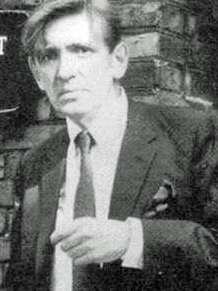 | |
| Born | Ralph Mozart Rosenborg June 9, 1913 Brooklyn, New York, U.S. |
| Died | October 22, 1992 (aged 79) Portland, Oregon, U.S. |
| Nationality | American |
| Known for | Artist |
Early life and training
Rosenborg was born in Brooklyn, New York, on June 9, 1913. In 1929, while he was a high school student, he began to work with the designer, artist, and instructor, Henriette Reiss.[3][4] When Rosenborg encountered her, Reiss was serving as an instructor for the School Art League in the American Museum of Natural History.[5][6][note 1] She was then engaged in instructing both students and their teachers in the city school system by a method she called Rhythmic Design.[6] She believed inspiration for abstract designs could be found in rhythms—rhythms that could be perceived in ordinary perceptions much as they are when listening to music. She said the rhythms of a musical composition might inspire a graphic pattern of forms and colors and in the same way rhythms perceived in a sunset or the ripples of a stream might be translated into a graphic design: anything seen, heard, or read might furnish an idea for a symbolic interpretation. She believed that rhythm is present everywhere and that students could be trained to sense its various manifestations.[10][11][note 2] In May 1930 Reiss selected a drawing by Rosenborg to be shown in an exhibition of creative design by City high school students.[5][12][note 3] From 1930 to 1933, aged 17 to 20, Rosenborg studied with Reiss in what Vivian Raynor of the New York Times called a "pupil-apprentice" relationship.[4] During this time she instructed him in music appreciation, literature, and art history as well as giving technical training in art.[1]
Career in art
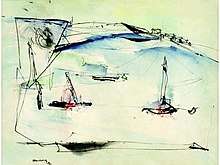
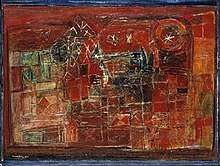
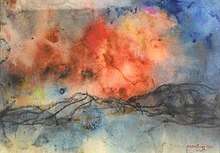
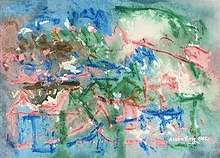
In April 1934 Rosenborg was one of 1,500 artists to participate in the annual Salons of America exhibition, which was held that year in Rockefeller Center's RCA Building.[3][13] Each paid two dollars for the privilege of hanging up to three works and none was given prominence over the others.[14] The New York Times reported that by the time the show closed a month later, some 30,000 people had viewed it.[15][note 4] The following year he was given a solo exhibition (his first) at the Lounge Gallery of the Eighth Street Playhouse.[3][note 5] The year after that he participated in a group show held by the Municipal Art Committee and in 1937 was given a second solo exhibition, this time in the Artists Gallery, which, like the Lounge Gallery, specialized in shows of deserving young artists who were unable to show in New York's commercial galleries.[3][19][note 6][note 7] That year he also became a founding member of and participated in a group show held by American Abstract Artists, a loose assembly of artists that aimed to promote abstract art and artists in New York.[2][24][note 8] At roughly the same time Rosenborg associated himself with a group of abstractionists that called itself "The Ten" and in May 1938 joined with its other members in what would be his first appearance in a commercial gallery: the Gallery Georgette Passedoit.[26][note 9][note 10] In 1938 he his work appeared in a group show at the Lounge Gallery, in 1939 in group shows at the Artists Gallery and (with other members of The Ten) at the Bonestell Gallery, and in 1940 yet another group show (with other members of American Abstract Artists) at the American Fine Arts Building.[note 11]
During this period Rosenborg began an association with an art dealer, Marian Guthrie Willard, that would last into the war years.[note 12] Willard was known for selecting artists whose work she admired without regard to their commercial potential. She aimed to nurture the careers of young artists whose work, as she put it, made "a personal statement as well as a vision of the universal."[33] In 1938 Rosenborg's paintings were included in group shows at her East River Gallery, in 1939 at a gallery she ran jointly with J.B Neumann called the Neumann-Willard Gallery, in 1942 at the Willard Gallery, and in 1943 at the same place.[note 13] Willard gave Rosenborg solo shows in February and November 1941.[38][39]
Rosenborg never had an exclusive long-term relationship with a commercial gallery. Throughout his career his work appeared in both group and solo shows in a wide variety of galleries and museums both in New York and elsewhere in the United States. Examples include the Phillips Memorial Gallery (group, 1941), Yale University Art Gallery (group, 1942), Brandt (group, 1944), the Pinacotheca (solo, 1945), Troeger-Phillips (solo, 1946), Chinese Gallery (solos, 1946 and 1947), Art Institute of Chicago (group, 1948), Corcoran Gallery of Art (groups, 1949 and 1959) Seligmann (solo, 1950), Davis (solos, 1953 and 1954), Delacorte (solo, 1955), and Landry (solo, 1959, 1960, and 1962).[note 14] He contributed paintings to exhibitions at the Whitney Museum of American Art in 1946, 1953, 1956, 1957, 1976, and 1990.[3] He was given retrospective exhibitions in 1982 at the Schlesinger-Boisanté Gallery and in 1983 at the Princeton Gallery of Fine Art.[51][4]
Artistic style and critical reception
Virginia M. Mecklenburg, The Patricia and Phillip Frost Collection: American Abstraction 1930–1945 (Washington, D.C.: Smithsonian Institution Press for the National Museum of American Art, 1989)
Unlike better-known abstract expressionists, Rosenborg made small paintings and gave preference to gouaches and watercolors over oils.[52][38] From his mentor, Henriette Reiss, he had learned a style of abstraction that involved symbolic interpretation of natural rhythms.[10] Critics noted a preference for a gestural abstraction rather than a geometrical one.[30][53] They also saw a persistent use of symbols, noting a similarity to the work of Wassily Kandinsky and Paul Klee.[note 15] Throughout his career critics further saw a distinct lyricism in Rosenborg's work.[note 16] Rosenborg's 1937 watercolor, "Abstracts in Blues and Greens" (at left above) illustrates his early watercolor style. "The Far-away City" of 1941 (at right above) illustrates his early style in oils. "American Landscape" (at left above) illustrates his late style in oils. "Landscape with Pink, Green, and Blue" (at right above) illustrates his late watercolor style.
His early work obscured the natural forms that inspired them making critics see them as tending toward pure abstraction. In the early 1950s he made a transition to a more clearly figurative expression.[45][47] These late works were said to give off an air of mystery.[44] Writing of a solo show held at the Landry Gallery in October 1960, Stuart Preston of the New York Times said, "The essence of mystery and magic is exactly what distinguishes Ralph Rosenborg's meditative semi-abstract landscape water-colors... These are rapturous little acts of visual and manual concentration at first sight inscrutable and then revealing themselves to be precise and allusive.[49] Writing about the same show, Bennett Schiff, critic for the New York Post, said "A mystical intensity and a beauty which burns in ruby and sapphire colors are in these fine paintings."[55]
Personal life and family
Rosenborg's birth name was Ralph Mozart Rosenborg.[56] He was born on June 9, 1913, to Mozart Wolfgang Rosenborg (October 28, 1884 to March 4, 1932) and his wife Helen Rosenborg (September 20, 1888 to September 28, 1947).[note 17] Both parents were born in Sweden. Rosenborg's father emigrated to New York in 1903 and lived in New York City.[60] During Rosenborg's childhood, he was a machinist.[57] Later he earned his living as a stockroom man.[58] His mother was sometimes a homemaker and sometimes earned a living as a cook.[4][61] As a child he had hoped to play the violin, but private lessons were beyond his family's means.[4] The art programs of the city's public schools and the privately-funded Art School League gave him the opportunity for no-cost art training and brought him into contact with Henriette Reiss who became his mentor and supporter.[4]
It is likely that sales of paintings never brought in enough money for Rosenborg to live on. Between 1936 and 1938 he taught classes at the Brooklyn Institute of Arts and Sciences and subsequently served as a guard for a year or two at the Museum of Non-Objective Painting.[3] Throughout his career he was thought to have relied on the women in his life for economic as well as emotional support—first his mother, then Louise Nevelson, with whom he had a passionate relationship between 1942 and 1948, then, briefly, her sister, Anita, and finally, his wife, Margaret, after they met in 1949 and married in 1951.[3][62]
Suffering from alcoholism and burdened with an erratic and often combative personality, he was said not to have a single close friend.[63]:150 According to Nevelson's biographer, "Rosenborg's gifts as a painter were undermined by his alcoholism, irascible temper, and adolescent-like quest for independence..."[63]:151 Another writer said he had an "exasperating character" and was "a legend in the art world for his suspicion of anything smacking of entanglement in social or professional relationships."[4]
After he was afflicted with a stroke in 1991, Rosenborg and his wife moved to her home town of Portland, Oregon, and there he died in a nursing home on October 22, 1992.[2][56]
Notes
- An outgrowth of the New York Art Committee of the Public Education Association, the School Art League was a philanthropic organization that worked closely with the city public school system and its museums to advance art literacy through lectures, demonstrations, studio classes, awards, and scholarships to students in elementary and high schools. The league was founded in 1909 and was still in existence in 2018.[7][8][9]
- Henriette Reiss (1889-1992) was born in England of Swiss parents. She was raised in Switzerland and studied painting, sculpture, and design in Munich, Basel, and Liverpool. In 1913 she moved to the United States with her husband, the painter Winold Reiss, and, after their divorce in 1923, became well-known first as a designer and then as the inventor of a method of art instruction she called the Henriette Reiss Method of Rhythmic Design. After teaching many years in the School Art League and other related positions, she ended her career as an instructor at the Fashion Institute of Technology.[6]
- The students' drawings were shown first at the American Museum of Natural History and later in Grand Central Palace. Contributing organizations included the School Art League Saturday morning class, taught by Reiss; the New York Evening School of Industrial Art, directed by Jennie Greenberg; and the Girls' Commercial High School, taught by Margaret Rigney.[12]
- Founded in 1922 by Hamilton Easter Field, Salons of America aimed to give artists an alternative to the Society of Independent Artists whose financial and publicity methods he found objectionable. A reporter said he aimed "to give equal opportunity to every member, whether he or she be a conservative or a post-Dadaist."[16]
- The gallery, sometimes called the Lounge Gallery and sometimes the Playhouse Gallery, was located in the Eighth Street Playhouse in Greenwich Village.[17] Originally called the Film Guild Cinema, the playhouse was the first theater built exclusively to show movies. In 1933 it began giving exhibitions in joint sponsorship with Vernon C. Porter's Artists' Aid Committee. The committee selected artists who had difficulty finding places in which to show their work and charged them no fee of any kind. Although it held occasional group shows, it specialized in giving solo shows to young artists who could not otherwise obtain gallery space.[17] By 1938, 120 artists had been given their first solo exhibitions there.[18]
- Mayor Fiorello La Guardia established the Municipal Art Committee in the fall of 1934 to provide employment for New York's musicians, performers, artists, and other out-of-work arts workers. Groups of artists submitted applications to the committee and its galleries' exhibitions were changed every two months.[20][21]
- Founded by Hugh S. Stix in 1936 and run by Frederica Beer, the Artists Gallery was supported by donations and charged no fees on artists' sales.[22][23]
- Calling the exhibition a "an often resounding mass demonstration of decorative design," Edward Alden Jewell of the New York Times said most of the works derived from European sources and showed little individuality.[25]
- Only one other member of The Ten, Louis Schanker, was also in American Abstract Artists. Formed in 1935 The Ten were considered to be both abstract and expressionist, although the term "abstract expressionist" was not then in current use.[27] Despite the name, it did not usually have ten members. There were only nine in the original group and when Rosenborg joined them there were only eight. Founding members were Ben-Zion, Ilya Bolotowsky, Adolph Gottlieb, Louis Harris, Jack Kufeld, Marcus Rothkowitz (later known as Mark Rothko), Louis Schanker, Joseph Solman, and Nahum Tschacbasov.[28]
- Noting an overall sombre tone in this show, the critic for the New York Sun said "the names of the artists suggest recent acclimatization and it is not always at once that newcomers pass into the glories and joys of living in America."[29]
- Lounge 1938,[18] Artists Gallery 1938,[30] Bonestell 1939,[31] American Fine Arts 1940[32]
- Willard married Dan Rhodes Johnson in the early 1940s thus becoming Marian Willard Johnson.
- East River,[34] Neumann-Willard,[35] 1942 Willard,[36] 1943 Willard[37]
- Phillips,[40] Yale,[3] Brandt,[3] Pinacotheca,[41] Troeger-Phillips,[3] Chinese,[42][43] Art Institute of Chicago,[3] Corcoran,[3] Seligmann,[44] Davis,[45][46] Delacorte,[47] Landry[48][49][50]
- See, for example, New York Post May 14, 1938,[26] New York Times November 9, 1941,[39] and New York Times November 11, 1946[54]
- See, for example, New York Times July 5, 1936,[19] New York Sun May 14, 1938,[29] New York Times November 11, 1945,[41] and New York Times October 15, 1982[51]
- Mozart birth,[57] Mozart death,[58] Helen birth and death[59]
References
- Virginia M. Mecklenburg (1989). The Patricia and Phillip Frost Collection: American Abstraction, 1930-1945. Washington, D.C., National Museum of American Art and Smithsonian Institution Press. p. 151.
Published for the exhibition, The Patricia and Phillip Frost Collection: American Abstraction 1930-1945
- "Ralph Rosenborg, 79, Abstract Painter, Dies". New York Times. New York, New York. 1992-10-27. p. B7.
- Zenobia Grant Wingate. "Ralph Rosenborg Biography". Caldwell Gallery. Retrieved 2019-06-18.
- Vivian Raynor (1983-03-27). "Princeton: 'Edible' Landscapes". New York Times. New York, New York. p. NJ28.
- "Student-Artists' Work on View". New York Sun. New York, New York. 1930-05-28. p. 43.
- "Henriette Reiss". Winhold Reiss, the Reiss Partnership. Retrieved 2019-06-23.
- "School Art League Meets: New Trustees Are Named by Group Fostering Work of Pupils". New York Times. New York, New York. 1931-12-06. p. N9.
- "Art in Schools Is Encouraged: Art School League, Founded Fifteen Years Ago, Seeks to Bring Out Talent and Offers Scholarships to Pupils". New York Times. New York, New York. 1925-11-15. p. X16.
- Carol Sterline (2018). "The School Art League". Education Update. Retrieved 2019-06-23.
- Anabel Parker McCann (1933-06-05). "You Can Feel Melody So Keenly That You'll Make Lovely Designs". New York Sun. New York, New York. p. 30.
[C]hildren, from kindergarten age, up through the elementary grades, the high schools and in evening classes, are now being taught design under the Reiss method.
- "Art in Iron That Came From the Anvil: Newark Museum Exhibition Displays the Handicraft Of Colonial Days". New York Times. New York, New York. 1930-05-18. p. SM8.
- "Local Art News Told in Brief". New York Times. New York, New York. 1930-05-11. p. 128.
- "3,500 Art Objects Arrive for Exhibit". New York Times. New York, New York. 1934-04-06. p. 25.
- "Salons Art Show Opened by Mayor". New York Times. New York, New York. 1934-04-10. p. 21.
- "Salons Exhibition to Close". New York Times. New York, New York. 1934-05-05. p. 20.
- "Salons of America a New Art Society". New York Times. New York, New York. 1922-07-03. p. 12.
- "Art Notes". New York Times. New York, New York. 1940-10-31. p. 20.
- "Playhouse Gallery Holds Retrospective". New York Post. New York, New York. 1938-06-04. p. 3.
- "Municipal and Federal". New York Times. New York, New York. 1936-07-05. p. X7.
- "Art Group Is Praised by Mrs. Breckinridge: Its Chairman Holds La Guardia Committee Has Earned Right to Financial Support". New York Times. 1936-04-18. p. 13.
- Edward Alden Jewell (1936-05-10). "The 'How' and the 'What'". New York Times. New York, New York. p. X7.
- "Display Ad: Artists' Gallery". New York Times. New York, New York. 1937-12-12. p. 202.
- "Artists Gallery". New York Times. New York, New York. 1940-04-28. p. 126.
- Susan C. Larsen (1974). "The American Abstract Artists: A Documentary History 1936-1941". Archives of American Art Journal. 14 (1): 2. JSTOR 1556919.
- Edward Alden Jewell (1937-04-06). "Abstract Artists Open Show Today: They Arrange 'Demonstration of Revolt Against Literary Subject". New York Times. New York, New York. p. 21.
- "The Ten Exhibit With New Lineup". New York Post. New York, New York. 1938-05-14. p. 26.
Ten pictures by The Ten (of whom there are only nine, to be sure, but guest exhibitor Karl Knaths plays Elijah on this occasion) agreeably ornament the Georgette Passedoit Gallery. Two changes are to be recorded in the regular line up. John Graham and Ralph M. Rosenborg are the newcomers. Both are effective, with special honors going to Rosenborg for his "Moonlight," a well-calculated essay in pictorial prismatics. The artist has profited by the study of Klee, but has not been imitative.
- Isabelle Dervaux (1991). "The Ten: An Avant-Garde Group in the 1930s". Archives of American Art Journal. University of Chicago Press, Archives of American Art, Smithsonian Institution. 31 (2): 14–20. JSTOR 1557715.
- Howard Devree (1935-12-22). "A Reviewer's Notebook". New York Times. New York, New York. p. X13.
- "Attractions in the Galleries". New York Sun. New York, New York. 1938-05-14. p. 10.
- Howard Devree (1938-10-30). "A Reviewer's Notebook: Of Foreign and Domestic Abstraction--Other Shows on the Art Calendar". New York Times. New York, New York. p. X10.
- Ray King (1939-10-30). "Exhibition by "The Ten" at the Bonestell". Daily Worker. New York, New York. p. 7.
'The Ten,' that group of mature modern painters, takes you well off the beaten path in their current exhibition at the Bonestell Gallery... These spiritual wanderers spurn the safe and sane routine of the bread-and-butter boys and prefer to explore new realms, generally uncharted. Sometimes they get lost in the vast jungle of the imagination, but that is the chance all explorers must take...Schanker and Rosenborg really have something new to say in their gaily colored extravaganzas
- Edward Alden Jewell (1940-06-05). "Gallery to Show Art of Van Gogh". New York Times. New York, New York. p. 2.
- Grace Gleuck (1985-11-07). "Marian Willard Johnson, 81, Dealer in Contemporary Art". New York Times. New York, New York. p. D27.
- Howard Devree (1938-06-12). "Pacing the Exhibitions". New York Times. New York, New York. p. 147.
- Howard Devree (1939-12-17). "A Reviewer's Notebook: Brief Comment on Some New Attractions In Galleries". New York Times. New York, New York. p. 132.
- "Groups and Solos". New York Times. New York, New York. 1942-10-18. p. X8.
- "Moderns". New York Times. New York, New York. 1943-12-12. p. X9.
- Howard Devree (1941-02-23). "A Reviewer's Notebook: Brief Comment on Some of the Recently Opened Shows". New York Times. New York, New York. p. X10.
Oils and gouaches by Ralph Rosenborg are on view at the Willard Gallery. Rosenborg seems to me to have more feeling for the lighter medium, which he uses fluently if quite without point.
- Howard Devree (1941-11-09). "A Reviewer's Notebook: Brief Comment on Some of the Recently Opened Shows". New York Times. New York, New York. p. X10.
Abandoning the earlier predominantly dark paintings lit by flashes of bright color, Ralph Rosenborg has brought to the Willard Gallery gouaches and water-colors that are more suave and lyric. He seems to be experimenting in some of them in a vein related to some of the color-impressions of Klee and Kandinsky, abstract in approach. His work as a whole is still rather tentative and emotional.
- "What's Going on and Where". Washington Post. Washington, D.C. 1941-02-04. p. 25.
- Howard Devree (1945-11-11). "Strangers Within Our Gates: Diversity of Others Other Exotics". New York Times. New York, New York. p. 51.
Ralph Rosenborg in his recent oils at the Pinacotheca has turned from the cryptic emotional shorthand of early work and is slowly heading out into open lyric expressionism. He seems to be bridging the gap in communication with the observer. 'Through the Window,' 'Dancing Landscape,' and "Many Things in the NIght" are packed with suggestion and several other canvases reveal the spirit and the forms striving to escape from the as yet inchoate materials.
- "Groups and Solos". New York Sun. New York, New York. 1946-06-03. p. 9.
Paintings and gouaches in the abstractionist vein are shown by Ralph Rosenborg at the Chinese Gallery. What Rosenborg has to say is purely personal. There is no hint of his intentions. Somehow it all seems to depend on whether or not you are attuned to his color vibrations. His gouaches draw the greatest response. In effect they are delicate line writings of indeterminate subject matter encompassed by what at times is deeply resonate color. A word of warning however: do not heed the titles.
- V.J.F. (1947-11-02). "Among the New Shows". New York Times. New York, New York. p. X9.
Ralph Rosenborg at the Chinese Gallery is said to be journeying away from non-objectivism, but he travels at a very measured pace. The lack of clarification in his work, pointed out last year, is still a barrier to some who respect him as a colorist with emotional impact. He continues to apply glowing pigment about as thickly as the canvas will allow, except in the two new pieces, vaguely suggestive of Modigliani in mood if not in method. Another innovation is Number 17 with its rather hieroblyphic design.
- S.H. (1948-10-08). "3 One-Man Shows in City Galleries". New York Times. New York, New York. p. 29.
Typical of much of the mystical feeling that has invaded recent painting are Ralph Rosenborg's oils at the Jacques Seligmann Gallery. Rosenborg turns his back on nature or, alternatively abstract design. Any visual or intellectual fact is apparently felt as a limitation here. Pursuing the happy accidents of medium (oil on paper) he manages to convey in veils of glowing color and nervous bands of pigment moods of mystery and archaic portent in a series of fantastic landscapes. Attached to a more definite system of design or some fruitful interior world of vital forms, this extremely passive, impressionistic method could carry weight. As it is, it has results of no enduring distinction, characterized by a trance-like monotony of fee-swirling color harmonics.
- Howard Devree (1953-10-18). "Round-Up and Solo". New York Times. New York, New York. p. X9.
The recent paintings by Ralph Rosenborg, at the Davis Gallery, represent an even more complete about-face. Always a rich colorist Rosenborg formerly leaned far over toward the nonobjective with heavily space-filling compositions of enigmatic significance. In his current show are assembled a score of small figure paintings, rich in color, each strongly silhouetted against a plain background. One tonal pastel-ish nude is the exception to a gallery-full of sturdily brushed forms in more solid colors. He has not pushed realization too far: it is as if he had listened to Boardman Robinson's famous dictum--'Don't finish up: carry on.' For there is even more of promise than of fulfillment in these small paintings in which he adds himself to the growing number of artists who have turned from extreme nonobjective work toward figurative expression.
- S.P. [i.e., Stuart Preston] (1954-11-06). "About Art and Artists: Exhibition Fetes John James Audubon, Proves Him Not the Lost Dauphin". New York Times. New York, New York. p. 15.
Ralph Rosenborg, whose new near-abstracts in oil are at the Davis Gallery, is a miniaturist. His paint texture is dense, fussy, rich and complex. He arranges it and its shifting colors with as much care as he would give to a bouquet of flowers. Really these pictures, which contain oblique references to nature, resemble nothing so much as tiles.
- D.A. [i.e., Dore Ashton] (1955-11-08). "Rosenborg Returns to Landscapes". New York Times. New York, New York. p. 28.
Coming back to landscape after a period of painting the figure, Rosenborg has gained in intensity and mystery. His thinly washed visions of the sea—Turneresque in delicacy—are nocturnes painted in resounding mauves. They are full of implied reflections. A ghostly elongated triangle of a ship rides in a deep blue envelope of night, or a barely noted wave flickers in unlimited sea and sky. In these, Rosenborg avoids obvious detail, preferring to let suggested forms emerge slowly for the spectator... The search for the universal symbol in Rosenborg's work is constant and fruitful.
- Stuart Preston (1959-11-08). "Art's Directions Old and New". New York Times. New York, New York. p. X15.
- Stuart Preston (1960-10-09). "Various International Episodes". New York Times. New York, New York. p. X13.
Suggestive Statements: The essence of mystery and magic is exactly what distinguishes Ralph Rosenborg's meditative semi-abstract landscape water-colors at the Albert Landry Gallery. These are rapturous little acts of visual and manual concentration at first sight inscrutable and then revealing themselves to be precise and allusive. Two blobs of light in dense purplish shadow look like no more than that until suddenly we recognize the encounter of two figures at twilight. The powers of suggestibility are developed delicately in the hands of this fine miniaturist.
- Stuart Preston (1962-02-25). "From the Sung Dynasty to Contemporaries". New York Times. New York, New York. p. X17.
- Grace Gleuck (1982-02-15). "Art: Reuben Nakian, 85, His Nymphs and Satyrs". New York Times. New York, New York. p. C19.
- "Small Works Can Make a Big Impact Abstract Impressionist show honors once-slighted artists who didn't produce large canvases". Christian Science Monitor. Boston, Massachusetts. 1990-11-16. p. D12.
- Edward Alden Jewell (1945-02-27). "By Our Modernists". New York Times. New York, New York. p. X6.
- "Among the New Shows". New York Times. New York, New York. 1946-06-09. p. 51.
Unless memory fails Ralph Rosenborg is having his third show of the years, this time at the Chinese Gallery. Generally non-objective in manner and primarily a colorist, he conveys a sense of emotion, but rarely disciplines his expression to the point of clarifying sufficiently to convey much more than that to this observer. Occasionally, as in 'Garden,' he can be suggestive. Some items stem from Klee. Rosenborg needs to overcome formlessness in his statements and consequent obscurity.
- Bennett Schiff (1960-10-09). "In the Art Galleries". New York Post. New York, New York. p. 12.
A mystical intensity and a beauty which burns in ruby and sapphire colors are in these fine paintings.
- "Ralph Mozart Rosenborg, 22 Oct 1992". "Oregon Death Index, 1903-1998," database, FamilySearch; citing Washington, Oregon, certificate number 92-21262, Oregon State Archives and Records Center, Salem. Retrieved 2019-06-16.
- "Mozart Wolfgang Rosenborg, 1917-1918". "United States World War I Draft Registration Cards, 1917-1918," database with images, FamilySearch; citing New York City no 20, New York, United States, NARA microfilm publication M1509 (Washington D.C.: National Archives and Records Administration, n.d.); FHL microfilm 1,754,131. Retrieved 2019-06-16.
- "Mozart Rosenborg, 04 Mar 1932". "New York, New York City Municipal Deaths, 1795-1949," database, FamilySearch; citing Death, Manhattan, New York, New York, United States, New York Municipal Archives, New York; FHL microfilm 2,069,578. Retrieved 2019-06-16.
- "Helen Rosenborg, 28 Sep 1947". "New York, New York City Municipal Deaths, 1795-1949," database, FamilySearch; citing Death, Manhattan, New York, New York, United States, New York Municipal Archives, New York; FHL microfilm 2,133,781. Retrieved 2019-06-16.
- Nina M.Nordby (2002-04-25). "Rosenborg". Anbytarforum. Retrieved 2019-06-18.
- "Helen Rosenborj, Assembly District 7, Bronx, New York City, Bronx, New York, United States". "United States Census, 1940," database with images, FamilySearch; citing enumeration district (ED) 3-1167, sheet 12B, line 57, family 226, Sixteenth Census of the United States, 1940, NARA digital publication T627. Records of the Bureau of the Census, 1790 - 2007, RG 29. Washington, D.C.: National Archives and Records Administration, 2012, roll 2489. Retrieved 2019-06-16.
- "Where's the Art? A Portrait of a Dead Artist, a Desperate Widow and Her Scheming Suitor". Willamette Week. Willamette, Oregon. 2005-05-17. Retrieved 2019-06-18.
- Laurie Wilson (16 December 2016). Louise Nevelson: Light and Shadow. Thames & Hudson. ISBN 978-0-500-77374-1.